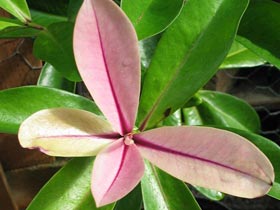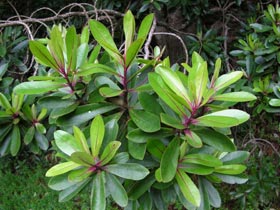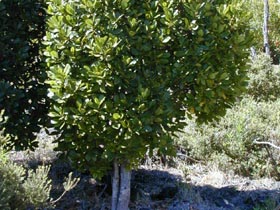Myrsine lessertiana
Genus
Myrsine
Species
lessertiana
Hawaiian Names with Diacritics
- Kōlea
- Kōlea lau nui
Hawaiian Names
- Kolea
- Kolea lau nui
Synonyms
- Myrsine emarginata
- Myrsine fauriei
- Myrsine fosbergii var. acuminata
- Myrsine gaudichaudii
- Myrsine meziana
- Rapanea emarginata
- Rapanea fosbergii var. acuminata
- Rapanea lessertiana
- Rapanea spathulata
- Suttonia cuneata
- Suttonia fauriei
- Suttonia flavida
- Suttonia hillebrandii var. emarginata
- Suttonia lessertiana
- Suttonia menziana
- Suttonia spathulata
Distribution Status
Endemic
Endangered Species Status
No Status
Plant Form / Growth Habit
- Tree
Mature Size, Height (in feet)
- Tree, Small, 15 to 30
- Tree, Medium, 30 to 50
Life Span
Long lived (Greater than 5 years)
Landscape Uses
- Accent
- Specimen Plant
Additional Landscape Use Information
There are a few kōlea (Mysine spp.) in cultivation. These are beautiful trees and shrubs that deserve the be grown more and used in the landscape.
Kōlea lau nui is a striking addition to landscapes with its bright magenta liko (new leaves) that fail to catch the eyes.
Use caution when transplanting as kōlea lau nui do not like root disturbance. [Rick Barboza, Hui Kū Maoli Ola]
Plant Produces Flowers
Yes
Flower Type
Not Showy
Flower Colors
- Green
- Purple
Additional Flower Color Information
Flowers are green-tinged purple or purple.
Blooming Period
- Spring
- Fall
- Winter
Additional Blooming Period and Fruiting Information
Kōlea lau nui blooms from fall through spring. Dark purple drupes usually grow along the upper stems of the plant.
Plant texture
- Coarse
Additional Plant Texture Information
Leaves of kōlea lau nui are 2 to 6 inches long.
Leaf Colors
- Light Green
Additional Leaf Color Information
The mature leaves are glossy light or dark green, while the liko (new leaves) are bright magenta, making it a stunning plant in the landscape.
Additional Pest & Disease Information
Kōlea lau nui are prone to attacks from ants, scale, mealy bugs, thrips and aphids. Plants are also subject to black twig borers.
Fertilizer
Kolea lau nui can be feed with small amounts of a slow release fertilizer such as 8-8-8 every 3 to 6 months.
Water Requirements
- Dry
Additional Water Information
When plant is well established, water twice a month or more during dry months.
Soil must be well drained
Yes
Light Conditions
- Full sun
- Partial sun
Natural Range
- Kauaʻi
- Oʻahu
- Molokaʻi
- Lānaʻi
- Maui
- Hawaiʻi
Natural Zones (Elevation in feet, Rainfall in inches)
- 150 to 1000, 50 to 100 (Mesic)
- 150 to 1000, Greater than 100 (Wet)
- 1000 to 1999, 50 to 100 (Mesic)
- 1000 to 1999, Greater than 100 (Wet)
- 2000 to 2999, 50 to 100 (Mesic)
- 2000 to 2999, Greater than 100 (Wet)
- 3000 to 3999, 50 to 100 (Mesic)
- 3000 to 3999, Greater than 100 (Wet)
- 4000 to 4999, 50 to 100 (Mesic)
- 4000 to 4999, Greater than 100 (Wet)
Additional Habitat Information
Normally found in mesic to wet forests sometimes into subalpine shrubland from around 700 to over 7,200 feet.
![]() Special Features and Information
Special Features and Information
General Information
Myrsine is in the Primrose family or Primulaceae.
Family members include garden flowers such as shooting star (Dodecatheon spp.), and of course, primrose (Pruimula spp.). But perhaps the most recognizable member, in name at least, is the scarlet pimpernel (Anagallis arvensis)--yes, a real plant, unlike the fictional character in the literature and play The Scarlet Pimpernel. Incidentally, this non-native is found in the islands and is generally considered a weed.
Kōlea lau nui (Myrsine lessertiana) is one of nineteen Myrsine spp. endemic to the Hawaiian Islands.
Other native family members include fourteen species of Lysimachia and the endemic kilioe (Embelia pacifica).
Etymology
The generic name Myrsine is comes from the ancient Greek pharmacologist and botanist Pedanius Dioscorides (c.40-90 CE) name for the myrtle, which did not refer to these plants.
The specific epithet is named for Baron Benjamin de Lessert (1773-1847), a French business man, naturalist, and author of Icones plantarum.
Early Hawaiian Use
Studies have found that early Hawaiian settlements in Waimanalo, dating close to A.D. 450 [450 C.E.], have fire pits with charcoal of kōlea lau nui within them and thus indicating that these plants grew much lower in elevation than it does today. [Rick Barboza, Hui Kū Maoli Ola]
Early Hawaiians used the strong wood for posts, gunwales for canoes, and beams in hale construction as well as to make anvils for beating kapa (tapa). [1,3]
Dye:
The pinkish bark produces a red sap was used to make red dye and the wood charcoal to make black dye. [3]
Medicinal:
The bark, leaves, and flowers of kōlea (Mysine spp.) were used medicinally to treat pāʻaoʻao (childhood disease, with physical weakening) and ʻea (thrush). [2]
Modern Use
Kōlea is is still used today for wood craft. [6]
Additional References
[1] "Plants in Hawaiian Culture" by Beatrice H. Krauss, pages 50, 325.
[2] "Native Hawaiian Medicine--Volume III" by The Rev. Kaluna M. Kaʻaiakamanu, pages 63-64.
[3] "Hawai'i's Plants and Animals--Biological Sketches of Hawaii Volcanoes National Park" by Charles P. Stone & Linda W. Pratt, page181.
[4] "Contemporary Woodworkers" by Tiffany DeEtte Shafto & Lynda McDaniel, page 206.
[5] "Common Forest Trees of Hawaii (Native and Introduced)" by Elbert L. Little Jr. and Roger G. Skolmen, page 312.
PHOTOS FOR THIS SPECIES CAN BE SEEN AT THE LINK (Copy & Paste to your browser):
https://www.flickr.com/search/?user_id=50823119%40N08&sort=date-taken-desc&view_all=1&text=Myrsine%20lessertiana
Plant Gallery
Back to Plant List
Other Nursery Profiles for Myrsine lessertiana



